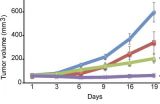(Press-News.org) Huntsville, Ala. – String bean, snap bean, haricot bean, and pinto and navy bean. These are just a few members of the common bean family — scientifically called Phaseolus vulgaris. These beans are critically important to the global food supply. They provide up to 15 percent of calories and 36 percent of daily protein for parts of Africa and the Americas and serve as a daily staple for hundreds of millions of people.
Now, an international collaboration of researchers, led by Jeremy Schmutz of the HudsonAlpha Institute for Biotechnology and Phillip McClean, of North Dakota State University (NDSU) have sequenced and analyzed the genome of the common bean to begin to identify genes involved in critical traits such as size, flavor, disease resistance and drought tolerance. The study was funded by the US Department of Agriculture, National Institute of Food and Agriculture and the US Department of Energy Office of Science.
The researchers learned that, unlike most other food crops, the common bean was domesticated twice by humans about 8,000 years ago — once in Mexico and once in South America — through the selection of largely non-overlapping, unique subsets of genes.
"We found very little overlap, and very little mixing, among the two domesticated populations," said Jeremy Schmutz, who co-directs the HudsonAlpha Institute's Genome Sequencing Center and serves as the Plant Program Leader for the Department of Energy Joint Genome Institute. "Evolutionarily, this makes the common bean very unique and interesting."
Schmutz shares lead authorship of the current study, which was published on June 8 in Nature Genetics, with Phillip McClean, director of the genomics and bioinformatics program at NDSU. Scott Jackson, from the University of Georgia, is the senior author.
The HudsonAlpha Genome Sequencing Center specializes in the production of reference plant genomes and genomic resources with a focus on improving agriculture and developing plant-based energy sources. In 2010, Schmutz led a team of researchers that used the Center's unique facilities to be the first to sequence the genome of the soybean — another vital global crop.
Identifying genes involved in the domestication of the common bean, and comparing locally adapted domesticated bean groups (called landraces) to their wild counterparts throughout Mexico and South America will help researchers understand how beans evolved, and how modern breeding programs might be improved to yield tastier, more-easily harvested, and, yes, even more-nutrient-packed beans. It may also help scientists to develop bean varieties resistant to pests, or better able to grow in challenging environments.
The common bean originated from a wild bean population in Mexico, and shares a common ancestor with the soybean. In addition to its role as a critical food crop, it serves as a partner in a symbiotic relationship with nitrogen-fixing bacteria to improve the soil in which it is planted.
"We're trying to understand what the common bean looked like before human intervention, to identify what occurred during early domestication and to apply that to modern bean breeding," said Schmutz. "Modern beans have been bred to fill specific expectations with regard to color, size and shape, and as a consequence have very little diversity. Studies such as this are necessary to identify genes that could be used to improve traits such as ease of harvest, flavor, yield and disease resistance."
Once genes are identified, they could be reintroduced into the population by selective breeding with wild populations, or careful breeding of existing landraces or even commercial beans. The Common Bean Coordinated Agricultural Project, or BeanCAP, launched in 2009 under the direction of study co-author McClean, is dedicated to the identification of gene markers that can be used in such breeding programs.
"The genome sequence has important implications for world-wide efforts to improve beans," said McClean. "The sequence will help breeders release varieties that are competitive with other crops and more climate resilient." The sequence revealed that disease resistance genes are highly clustered in the genome, knowledge that will lead to better breeding strategies to combat the many diseases that challenge the bean crop. Data from the study is being actively used by the many international bean breeders and geneticists to develop the next generation of molecular markers to aid bean breeding efforts.
From a global perspective, this information could be beneficial to farmers in developing countries that practice the intercropping system known as "milpa", where beans, corn, and occasionally squash, are planted together. The historical practice ensures that their land can continue to produce high-yield crops without resorting to adding fertilizers or other chemical methods of providing nutrients to the soil. McClean noted that "Breeders and genomic scientists in these countries are already working with the international bean community to utilize this important new genetic resource to address the production constraints unique to the "milpa" system."
INFORMATION: END
Common bean genome sequence provides powerful tools to improve critical food crop
2014-06-09
ELSE PRESS RELEASES FROM THIS DATE:
Sequencing of citrus genomes points to need for more genetic diversity to fight disease
2014-06-09
Huntsville, Ala. – Sequencing the genomes of domesticated citrus revealed a very limited genetic diversity that could threaten the crop's survival prospects, according to an international research team. In a study published in the June issue of Nature Biotechnology, the international consortium of researchers from the United States, France, Italy, Spain and Brazil analyzed and compared the genome sequences of 10 diverse citrus varieties, including sweet and sour orange along with several important mandarin and pummelo cultivars. The findings provide the clearest insight ...
Combination therapy may help patients with follicular lymphoma
2014-06-09
A new study in The Journal of Experimental Medicine reveals that a high-risk group of patients with follicular lymphoma could benefit from a novel drug combination.
Follicular lymphoma, a B cell lymphoma, is an incurable form of non-Hodgkin lymphoma that is diagnosed each year in 120,000 people worldwide. Follicular lymphoma is characterized by slow and relentless tumor growth with inevitable relapses despite intense chemotherapy. Follicular lymphomas are driven by mutations that activate the BCL2 protein, which prevents cancer cells from dying, but additional genetic ...
No limits to human effects on clouds
2014-06-09
Understanding how clouds affect the climate has been a difficult proposition. What controls the makeup of the low clouds that cool the atmosphere or the high ones that trap heat underneath? How does human activity change patterns of cloud formation? The research of the Weizmann Institute's Prof. Ilan Koren suggests we may be nudging cloud formation in the direction of added area and height. He and his team have analyzed a unique type of cloud formation; their findings, which appeared recently in Science indicate that in pre-industrial times, there was less cloud cover over ...
UNC researchers pinpoint new role for enzyme in DNA repair, kidney cancer
2014-06-09
CHAPEL HILL, N.C. – Twelve years ago, UNC School of Medicine researcher Brian Strahl, PhD, found that a protein called Set2 plays a role in how yeast genes are expressed – specifically how DNA gets transcribed into messenger RNA. Now his lab has found that Set2 is also a major player in DNA repair, a complicated and crucial process that can lead to the development of cancer cells if the repair goes wrong.
"We found that if Set2 is mutated, DNA repair does not properly occur" said Strahl, a professor of biochemistry and biophysics. "One consequence could be that if you ...
Did violence shape our faces?
2014-06-09
(Salt Lake City) —What contributed to the evolution of faces in the ape-like ancestors of humans?
The prehistoric version of a bar fight —over women, resources and other slug-worthy disagreements, new research from the University of Utah scheduled for publication in the journal Biological Reviews on June 9 suggests.
University of Utah biologist David Carrier and Michael H. Morgan, a University of Utah physician, contend that human faces —especially those of our australopith ancestors — evolved to minimize injury from punches to the face during fights between males. ...
Iron supplements improve anemia, quality of life for women with heavy periods
2014-06-09
A study by researchers from Finland found that diagnosis and treatment of anemia is important to improve quality of life among women with heavy periods. Findings published in Acta Obstetricia et Gynecologica Scandinavica, a journal of the Nordic Federation of Societies of Obstetrics and Gynecology, suggest clinicians screen for anemia and recommend iron supplementation to women with heavy menstrual bleeding (menorrhagia).
One of the common causes of iron deficiency and anemia is heavy bleeding during menstration. Over time monthly mentrual iron loss without adequate ...
Most breast cancer patients may not be getting enough exercise
2014-06-09
Physical activity after breast cancer diagnosis has been linked with prolonged survival and improved quality of life, but most participants in a large breast cancer study did not meet national physical activity guidelines after they were diagnosed. Moreover, African-American women were less likely to meet the guidelines than white women. Published early online in CANCER, a peer-reviewed journal of the American Cancer Society, the findings indicate that efforts to promote physical activity in breast cancer patients may need to be significantly enhanced.
The US Department ...
Longer telomeres linked to risk of brain cancer
2014-06-08
New genomic research led by UC San Francisco (UCSF) scientists reveals that two common gene variants that lead to longer telomeres, the caps on chromosome ends thought by many scientists to confer health by protecting cells from aging, also significantly increase the risk of developing the deadly brain cancers known as gliomas.
The genetic variants, in two telomere-related genes known as TERT and TERC, are respectively carried by 51 percent and 72 percent of the general population. Because it is somewhat unusual for such risk-conferring variants to be carried by a majority ...
New molecule enables quick drug monitoring
2014-06-08
Monitoring the drug concentration in patients is critical for effective treatment, especially in cases of cancer, heart disease, epilepsy and immunosuppression after organ transplants. However, current methods are expensive, time-consuming, and require dedicated personnel and infrastructure away from the patient. Publishing in Nature Chemical Biology, scientists at EPFL introduce novel light-emitting sensor proteins that can quickly and simply show how much drug is in a patient's bloodstream by changing the color of their light. The method is so simple that it could be ...
Retracing early cultivation steps: Lessons from comparing citrus genomes
2014-06-08
Citrus is the world's most widely cultivated fruit crop. In the U.S. alone, the citrus crop was valued at over $3.1 billion in 2013. Originally domesticated in Southeast Asia thousands of years ago before spreading throughout Asia, Europe, and the Americas via trade, citrus is now under attack from citrus greening, an insidious emerging infectious disease that is destroying entire orchards. To help defend citrus against this disease and other threats, researchers worldwide are mobilizing to apply genomic tools and approaches to understand how citrus varieties arose and ...




